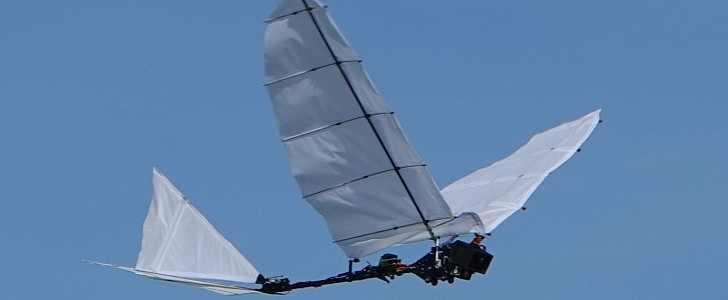Inspired by nature, a group of researchers from the University of Seville in Spain has developed autonomous bird-like robots that can flap their wings, fly, perch, and more. Their ultimate goal is to use the robots for places that rotorcraft cannot reach.
Usually, on a full charge, a drone can fly around 20 to 30 minutes. This new technology that professor Anibal Ollero, an electrical engineer at the University of Seville in Spain, and his team want to implement would double that numer. In order to increase the flight time, the team plans to use the wind and airflows.
Their GRIFFIN project aims to develop autonomous robots that can fly with minimal energy usage, sit on curved surfaces, and execute dexterous manipulation. Called ornithopters, the prototypes take inspiration from birds by selecting relevant elements that can assist them. To conserve energy, researchers are using the wind to propel the robots. As for navigation, there are onboard computers and cameras that help the robot bird.
Because there are no propellers and soft, flexible materials such as microfibre composites and nylon make the wings and tail, professor Ollero believes that this design can also reduce noise and improve safety in specific scenarios. For example, one scenario in which the ornithopters could help would be to land on injured people and analyze their state without causing further harm.
Another would be to gain access to regions where humans are unable to enter due to the presence of gases. Bird robots may land on a pipe and detect corrosion in industrial plants, for example.
Started in 2018, the project has met great progress. Indoor and outdoor flight was proved to be successful by using flapping wings. Furthermore, landing on a small square platform about 30 cm (11.8 in) wide was also demonstrated. The team’s next step is to get the birds to land on poles or wires and maintain their equilibrium.
Even though professor Ollero says that ”there is a lot of work to do on the integration of new technologies related to material science, mechanics, aerodynamics and artificial intelligence in the robotic birds,” he believes that by 2030, the ornithopters will be capable of doing complex autonomous tasks.
The team’s work was published in the EU Research and Innovation Magazine, and their GRIFFIN project is currently EU-funded.
Their GRIFFIN project aims to develop autonomous robots that can fly with minimal energy usage, sit on curved surfaces, and execute dexterous manipulation. Called ornithopters, the prototypes take inspiration from birds by selecting relevant elements that can assist them. To conserve energy, researchers are using the wind to propel the robots. As for navigation, there are onboard computers and cameras that help the robot bird.
Because there are no propellers and soft, flexible materials such as microfibre composites and nylon make the wings and tail, professor Ollero believes that this design can also reduce noise and improve safety in specific scenarios. For example, one scenario in which the ornithopters could help would be to land on injured people and analyze their state without causing further harm.
Another would be to gain access to regions where humans are unable to enter due to the presence of gases. Bird robots may land on a pipe and detect corrosion in industrial plants, for example.
Started in 2018, the project has met great progress. Indoor and outdoor flight was proved to be successful by using flapping wings. Furthermore, landing on a small square platform about 30 cm (11.8 in) wide was also demonstrated. The team’s next step is to get the birds to land on poles or wires and maintain their equilibrium.
Even though professor Ollero says that ”there is a lot of work to do on the integration of new technologies related to material science, mechanics, aerodynamics and artificial intelligence in the robotic birds,” he believes that by 2030, the ornithopters will be capable of doing complex autonomous tasks.
The team’s work was published in the EU Research and Innovation Magazine, and their GRIFFIN project is currently EU-funded.






